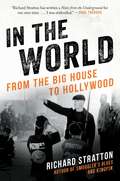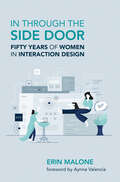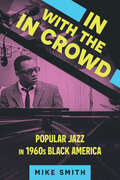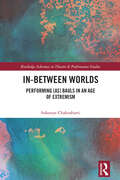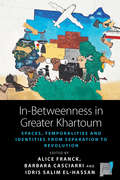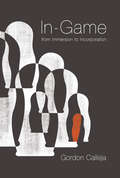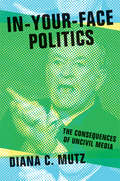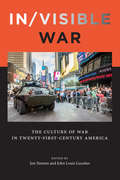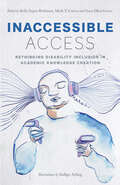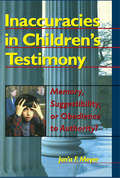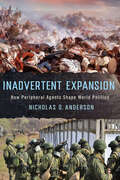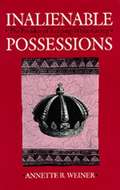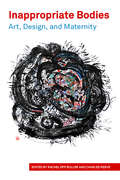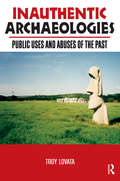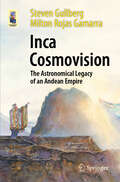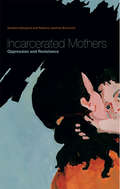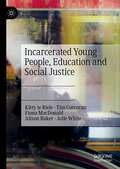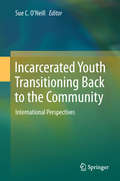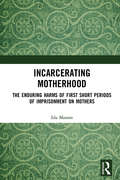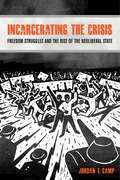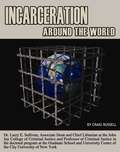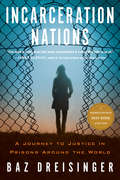- Table View
- List View
In the World: From the Big House to Hollywood (Cannabis Americana: Remembrance of the War on Plants, Book 3) (Cannabis Americana: Remembrance of the W #3)
by Richard StrattonThe Hollywood Ending of an Adrenaline-Filled and, By Turns, Harrowing and Funny Odyssey of Crime and Redemption in America's War on DrugsSmuggler's Blues, the first book in Richard Stratton's memoir of his criminal career, detailed his years as a kingpin in the Hippie Mafia. Kingpin, the second book, traced his eight-year journey through the criminal justice system, through two federal trials and myriad jails and prisons, and culminating in his success as a self-taught jailhouse lawyer in winning his own release. In this final volume, Stratton recounts his return to civilian life, as a convicted felon who had been forced to confront his demons and an aspiring writer who yearned to make his mark. From parole to Hollywood to marriage and fatherhood, he found his way in the free world. Working in the New York office of a criminal defense attorney, he somehow adhered to the stringent conditions of his release not to associate with other felons. When his prison novel Smack Goddess was published, his mentor, Norman Mailer, entered his life again. Going to Hollywood to consult on a documentary, he became a writer and producer, and his feature film Slam won major awards at Sundance and Cannes. In the World includes profiles of celebrities such as Mailer, Oliver Stone, Sean Penn, and others.
In through the Side Door: Fifty Years of Women in Interaction Design
by Erin MaloneThe vital story of how women designers and researchers pioneered the field of interaction and user experience design for software and digital interfaces.Framed against the backdrop of contemporary waves of feminism and the history of computing design, In through the Side Door foregrounds the stories of the women working in the field of computing and the emergent discipline of interaction design as the graphical user interface was developed. Erin Malone begins with a handful of pioneers who brought to the field various methods from a variety of backgrounds including design, technical communication, social psychology, ethnography, information science, and mechanical engineering. Moving into the early days of desktop computing, the book highlights the women on the teams inventing contemporary desktop computer interfaces and related tools, including those at Xerox PARC, Apple&’s Human Interface Group, and Microsoft.Malone takes the reader through the invention of the World Wide Web, the third wave of feminism, and the dot-com boom and bust. Coming up to contemporary times, the book features women working on the web, designing equipment interfaces, and working in voice UX, mobile design, and civic design, and continues with the up-and-coming leaders driving social impact, changing human-centered design and research, and working to be accountable for the harms of contemporary software products. Along the way, the author also touches on the challenges and biases women have faced in the workplace and continue to encounter despite cultural and sociological advancements.
In with the In Crowd: Popular Jazz in 1960s Black America (American Made Music Series)
by Mike SmithMost studies of 1960s jazz underscore the sounds of famous avant-garde musicians like John Coltrane, Ornette Coleman, and Albert Ayler. Conspicuously absent from these narratives are the more popular jazz artists of the decade that electrified dance clubs, permeated radio waves, and released top-selling records. Names like Eddie Harris, Nancy Wilson, Ramsey Lewis, and Jimmy Smith are largely neglected in most serious work today. Mike Smith rectifies this oversight and explores why critical writings have generally cast off best-selling 1960s jazz as unworthy of in-depth analysis and reverent documentation.The 1960s were a time of monumental political and social shifts. Avant-garde jazz, made by musicians indifferent to public perception aligns well with widely held images of the era. In with the In Crowd: Popular Jazz in 1960s Black America argues that this dominant, and unfortunately distorted, view negates and ignores a vibrant jazz community. These musicians and their listeners created a music defined by socialization, celebration, and Black pride.Smith tells the joyful story of the musicians, the radio DJs, the record labels, and the live venues where jazz not only survived but thrived in the 1960s. This was the music of everyday people, who viewed jazz as an important part of their cultural identity as Black Americans. In an era marked by turmoil and struggle, popular jazz offered a powerful outlet for joy, resilience, pride, and triumph.
In-Between Worlds: Performing [as] Bauls in an Age of Extremism (Routledge Advances in Theatre & Performance Studies)
by Sukanya ChakrabartiThis book examines the performance of Bauls ‘folk’ performers from Bengal, in the context of a rapidly globalizing Indian economy and against the backdrop of extreme nationalistic discourses. Recognizing their scope beyond the musical and cultural realm, Sukanya Chakrabarti engages in discussing the subversive and transformational potency of Bauls and their performances. In-Between Worlds argues that the Bauls through their musical, spiritual, and cultural performances offer ‘joy’ and ‘spirituality,’ thus making space for what Dr. Ambedkar in his famous 1942 speech had identified as ‘reclamation of human personality’. Chakrabarti destabilizes the category of ‘folk’ as a fixed classification or an origin point, and fractures homogeneous historical representations of the Baul as a ‘folk’ performer and a wandering mendicant exposing the complex heterogeneity that characterizes this group. Establishing ‘folk-ness’ as a performance category, and ‘folk festivals’ as sites of performing ‘folk-ness,’ contributing to a heritage industry that thrives on imagined and recreated nostalgia, Chakrabarti examines different sites that produce varied performative identities of Bauls, probing the limits of such categories while simultaneously advocating for polyvocality and multifocality. While this project has grounded itself firmly in performance studies, it has borrowed extensively from fields of postcolonial studies and subaltern histories, literature, ethnography and ethnomusicology, and cosmopolitan studies.
In-Betweenness in Greater Khartoum: Spaces, Temporalities, and Identities from Separation to Revolution (Space and Place #20)
by Alice Franck, Barbara Casciarri Idris Salim El-HassanFocusing on Greater Khartoum following South Sudanese independence in 2011, In-Betweenness in Greater Khartoum explores the impact on society of major political events in areas that are neither urban nor rural, public nor private. This volume uses these in-between spaces as a lens to analyze how these events, in combination with other processes, such as globalization and economic neo-liberalization, impact communities across the region. Drawing on original fieldwork and empirical data, the authors uncover the reshaping of new categories of people that reinforce old dichotomies and in doing so underscore a common Sudanese identity.
In-Game: From Immersion to Incorporation
by Gordon CallejaAn investigation of what makes digital games engaging to players and a reexamination of the concept of immersion.Digital games offer a vast range of engaging experiences, from the serene exploration of beautifully rendered landscapes to the deeply cognitive challenges presented by strategic simulations to the adrenaline rush of competitive team-based shoot-outs. Digital games enable experiences that are considerably different from a reader's engagement with literature or a moviegoer's experience of a movie. In In-Game, Gordon Calleja examines what exactly it is that makes digital games so uniquely involving and offers a new, more precise, and game-specific formulation of this involvement. One of the most commonly yet vaguely deployed concepts in the industry and academia alike is immersion—a player's sensation of inhabiting the space represented onscreen. Overuse of this term has diminished its analytical value and confused its meaning, both in analysis and design. Rather than conceiving of immersion as a single experience, Calleja views it as blending different experiential phenomena afforded by involving gameplay. He proposes a framework (based on qualitative research) to describe these phenomena: the player involvement model. This model encompasses two constituent temporal phases—the macro, representing offline involvement, and the micro, representing moment-to-moment involvement during gameplay—as well as six dimensions of player involvement: kinesthetic, spatial, shared, narrative, affective, and ludic. The intensified and internalized experiential blend can culminate in incorporation—a concept that Calleja proposes as an alternative to the problematic immersion. Incorporation, he argues, is a more accurate metaphor, providing a robust foundation for future research and design.
In-Your-Face Politics
by Diana C. MutzAmericans are disgusted with watching politicians screaming and yelling at one another on television. But does all the noise really make a difference? Drawing on numerous studies, Diana Mutz provides the first comprehensive look at the consequences of in-your-face politics. Her book contradicts the conventional wisdom by documenting both the benefits and the drawbacks of in-your-face media. "In-your-face" politics refers to both the level of incivility and the up-close and personal way that we experience political conflict on television. Just as actual physical closeness intensifies people's emotional reactions to others, the appearance of closeness on a video screen has similar effects. We tend to keep our distance from those with whom we disagree. Modern media, however, puts those we dislike in our faces in a way that intensifies our negative reactions. Mutz finds that incivility is particularly detrimental to facilitating respect for oppositional political viewpoints and to citizens' levels of trust in politicians and the political process. On the positive side, incivility and close-up camera perspectives contribute to making politics more physiologically arousing and entertaining to viewers. This encourages more attention to political programs, stimulates recall of the content, and encourages people to relay content to others. In the end, In-Your-Face Politics demonstrates why political incivility is not easily dismissed as a disservice to democracy--it may even be a necessity in an age with so much competition for citizens' attention.
In/visible War: The Culture of War in Twenty-first-Century America
by John Louis Lucaites Purnima Bose David Campbell Diane Rubenstein Wendy Kozol Nina Berman Rebecca A. Adelman James Der Derian Christopher J. Gilbert Claudia Breger De Witt Kilgore Jeremy G. Gordon Jody Madeira Jon Simons Roger StahlIn/Visible War addresses a paradox of twenty-first century American warfare. The contemporary visual American experience of war is ubiquitous, and yet war is simultaneously invisible or absent; we lack a lived sense that “America” is at war. This paradox of in/visibility concerns the gap between the experiences of war zones and the visual, mediated experience of war in public, popular culture, which absents and renders invisible the former. Large portions of the domestic public experience war only at a distance. For these citizens, war seems abstract, or may even seem to have disappeared altogether due to a relative absence of visual images of casualties. Perhaps even more significantly, wars can be fought without sacrifice by the vast majority of Americans. Yet, the normalization of twenty-first century war also renders it highly visible. War is made visible through popular, commercial, mediated culture. The spectacle of war occupies the contemporary public sphere in the forms of celebrations at athletic events and in films, video games, and other media, coming together as MIME, the Military-Industrial-Media-Entertainment Network.
Inaccessible Access: Rethinking Disability Inclusion in Academic Knowledge Creation
by Michele Friedner Sumi Colligan Mark T. Carew Erin L. Durban Indigo Ayling Carol Rivas Julia F. Sauma Julia K. Modern Valéria Aydos Harshadha Balasubramanian Rebekah Cupitt Sara M. Acevedo Valerie Black Nell A. Koneczny Krisjon Olson Mark R. BookmanInaccessible Access ethnographically addresses barriers to inclusion within knowledge-making. It focuses on the social, environmental, communicative, and epistemological barriers that people with disabilities confront and embody throughout the course of their learning and living and in the specific context of their higher education institutions and in research. It is presented by a neurodiverse, disabled, and non-cis cohort of authors, all of whom acknowledge a continuum of (in)access that is available to each contributor contingent on their inherent intersectionalities and alterities. The authors and editors of this book foreground the work that has yet to be done on recognizing the value of nonnormative ways of approaching, being in, and knowing research and higher education, particularly in cases where disablity-centered epistemologies are sidelined in confrontation with institutional norms, even within existing discourses concerning equality and alterity.
Inaccuracies in Children's Testimony: Memory, Suggestibility, or Obedience to Authority?
by Letitia C Pallone Jon'A F MeyerInaccuracies in Children’s Testimony combines the literature on obedience to authority with that on suggestibility to create a third literature. This book examines children’s testimony from several perspectives and gives you insightful suggestions for increasing children’s abilities to testify accurately about traumatic things that have happened to them. In doing so, you’ll learn how to ensure that those who abuse or sexually exploit children are brought to justice while those falsely accused are adequately protected.How children are questioned to learn what they have witnessed is crucial due to the effects the questioning sessions may have on their testimonies--improper questioning may lead to inaccurate answers. This is just one of the many areas of children’s testimony covered in Inaccuracies in Children’s Testimony. In each of the chapters you’ll discover new ways for increasing the accuracy and dependability of children’s testimony as you read about: factors that affect children’s testimonies suggestibility--definition and research, including sources of suggestibility how obedience to authority can explain children’s behavior as witnesses children’s memory in the courtroom and what they are able to remember how children’s involvement in the courts can be problematic free versus prompted recall--which is more accurate and why the “worst” method is often used with children Milgram’s theory of obedience to authority tied to children as witnesses review of the literature on the effects of stress, prompting, and imagination on children’s recall ideas for future researchExperts in the field of legal testimony, legal personnel, child counselors, psychologists, social workers, and faculty and students of related courses will find Inaccuracies in Children’s Testimony an essential resource for understanding the importance of making the child victim/witness more believable and reliable.
Inadvertent Expansion: How Peripheral Agents Shape World Politics
by Nicholas D. AndersonIn Inadvertent Expansion, Nicholas D. Anderson investigates a surprisingly common yet overlooked phenomenon in the history of great power politics: territorial expansion that was neither intended nor initially authorized by state leaders. Territorial expansion is typically understood as a centrally driven and often strategic activity. But as Anderson shows, nearly a quarter of great power coercive territorial acquisitions since the nineteenth century have in fact been instances of what he calls "inadvertent expansion." A two-step process, inadvertent expansion first involves agents on the periphery of a state or empire acquiring territory without the authorization or knowledge of higher-ups. Leaders in the capital must then decide whether to accept or reject the already-acquired territory.Through cases ranging from those of the United States in Florida and Texas to Japan in Manchuria and Germany in East Africa, Anderson shows that inadvertent expansion is rooted in a principal-agent problem. When leaders in the capital fail to exert or have limited control over their agents on the periphery, unauthorized efforts to take territory are more likely to occur. Yet it is only when the geopolitical risks associated with keeping the acquired territory are perceived to be low that leaders are more likely to accept such expansion. Accentuating the influence of small, seemingly insignificant actors over the foreign policy behavior of powerful states, Inadvertent Expansion offers new insights into how the boundaries of states and empires came to be and captures timeless dynamics between state leaders and their peripheral agents.
Inalienable Possessions: The Paradox of Keeping-while-Giving
by Annette B. WeinerInalienable Possessions tests anthropology's traditional assumptions about kinship, economics, power, and gender in an exciting challenge to accepted theories of reciprocity and marriage exchange. Focusing on Oceania societies from Polynesia to Papua New Guinea and including Australian Aborigine groups, Annette Weiner investigates the category of possessions that must not be given or, if they are circulated, must return finally to the giver. Reciprocity, she says, is only the superficial aspect of exchange, which overlays much more politically powerful strategies of "keeping-while-giving. " The idea of keeping-while-giving places women at the heart of the political process, however much that process may vary in different societies, for women possess a wealth of their own that gives them power. Power is intimately involved in cultural reproduction, and Weiner describes the location of power in each society, showing how the degree of control over the production and distribution of cloth wealth coincides with women's rank and the development of hierarchy in the community. Other inalienable possessions, whether material objects, landed property, ancestral myths, or sacred knowledge, bestow social identity and rank as well. Calling attention to their presence in Western history, Weiner points out that her formulations are not limited to Oceania. The paradox of keeping-while-giving is a concept certain to influence future developments in ethnography and the theoretical study of gender and exchange.
Inanna: Queen of Heaven and Earth
by Diane Wolkstein Samuel Noah KramerStories and hymns to Inanna and some history of the land which is now part of Iraq.
Inappropriate Bodies Art, Design and Maternity
by Buller Rachel EppThis edited collection examines conflicting assumptions, expectations, and perceptions of maternity in artistic, cultural, and institutional contexts. Over the past two decades, the maternal body has gained currency in popular culture and the contemporary art world, with many books and exhibitions foregrounding artists’ experiences and art historical explorations of maternity that previously were marginalized or dismissed. In too many instances, however, the maternal potential of female bodies—whether realized or not—still causes them to be stigmatized, censored, or otherwise treated as inappropriate: cultural expectations of maternity create one set of prejudices against women whose bodies or experiences do align with those same expectations, and another set of prejudices against those whose do not. Support for mothers in the paid workforce remains woefully inadequate, yet in many cultural contexts, social norms continue to ask what is “wrong” with women who do not have children. In these essays and conversations, artists and writers discuss how maternal expectations shape both creative work and designed environments, and highlight alternative ways of existing in relation to those expectations.
Inauthentic Archaeologies: Public Uses and Abuses of the Past
by Troy R LovataArchaeology has an impact on the public far beyond what any archaeologist would imagine. In this concise, student-friendly look at the public appropriation of archaeology, Troy Lovata examines outright hoaxes, fanciful re-creations, artistic representations, commercial enterprises, and discredited replicas of the past. The book explores examples from around the world and across time to help readers understand how the past becomes social currency for both professional archaeologists and the public at large. Lovata addresses central questions of authenticity, ownership of the past, and the use of archaeology by everyone from artists to multinational corporations. Examples include the Piltdown Hoax, replica Anasazi cliff dwellings at Manitou Springs, Colorado, reconstructed Spanish torreons, and playful Stonehenge replicas. Student exercises, cartoons, interviews, and illustrations add to the pedagogical value of this concise, fascinating work for students in introductory archaeology classes.
Inca Cosmovision: The Astronomical Legacy of an Andean Empire (Astronomers' Universe)
by Steven Gullberg Milton Rojas GamarraThe Inkas (Quechua spelling) worshipped the Sun, and their emperor was thought to be the son of the Sun. They conquered most of the Andes and their former empire is replete with examples of their astronomy. They used solar positions on the horizon for calendrical purposes and managed their crops and religious festivals in this manner. Many examples remain of their intentional light and shadow effects that demonstrate their sophisticated understanding of the Sun’s movement and of solar horizon events. Evidence of their astronomy can only be fully understood in its cultural context, and that is the focus of this book. Inka Cosmovision explores the cosmic worldview of the Inkas from the perspective of oral traditions passed from one generation to the next among the Inkas’ living descendants. You will learn about Inka astronomy in a way that you perhaps have never encountered. An author of the book is Quechua, a descendant of the Inkas, and what you will read benefits greatly not only from the field research of both authors, but from the many stories he learned from his parents and grandparents and from his Amauta, a highly respected Indigenous teacher of Inka culture. This book enlightens about Inka cosmovision as no other has before.
Incantations: Songs, Spells and Images by Mayan Women
by Ambar PastThis book of poems and stark, vivid illustrations is rooted in the female soul of indigenous Mexico. The Tzotzil women of the Chiapas Highlands are the poets and the artists. Ambar Past, who collected the poems and drawings, includes a moving essay about their poetics, beliefs, and history.In the 1970s, living among the Maya, Past watched the people endure as an epidemic swept through a village. No help came. Many children died. One mother offered her dead child a last sip of Coca-Cola and uttered a prayer: Take this sweet dew from the earth, take this honey. It will help you on your way. It will give you strength on your path.Incantations like this--poems about birth, love, hate, sex, despair, and death--coupled with primitive illustrations, provide a compelling insight into the psychology of these Mayan women poets. The Cinco Puntos edition of Incantations is a facsimile of the original handmade edition produced by the Taller Leñateros. It was reviewed in The New York Times.At the age of twenty-three, Ambar Past left the United States for Mexico. She lived among the Mayan people, teaching the techniques of native dyes and learning to speak Tzotzil. She is the creator of the graphic arts collective Taller Leñateros in Chiapas and was a founding member of Sna Jolobil, a weaving cooperative for Mayan artisans.
Incarcerated Mothers: Oppression And Resistance
by Gordana EljdupovicA large proportion—and in many jurisdictions the majority—of incarcerated women are mothers. Popular attention is often paid to challenges faced by children of incarcerated mothers while incarcerated women themselves often do not “count” as mothers in mainstream discourse. This is the first anthology on incarcerated mothers’ experiences that is primarily based on and reflects the Canadian context. It is also trans- national in scope as it covers related issues from other countries around the world. These essays examine connections between mothering and incarceration, from analysis of the justice system and policies, criminalization of motherhood, to understanding experiences of mothers in prisons as presented in their own voices. They highlight structures and processes which shape and ascribe incarcerated woman’s identity as a mother, juxtaposing it with scripted and imposed mainstream norms of a “good” or “real” mother. Moreover, these essays identify and track emergence of mothers’ resistance and agency within and in spite of the confines of their circumstances.
Incarcerated Young People, Education and Social Justice
by Tim Corcoran Fiona MacDonald Julie White Kitty te Riele Alison BakerThis book foregrounds the provision of education for young people who have been remanded or sentenced into custody. Both international conventions and national legislation and guidelines in many countries point to the right of children and young people to access education while they are incarcerated. Moreover, education is often seen as an important protective and ‘rehabilitative’ factor. However, the conditions associated with incarceration generate particular challenges for enabling participation in education. Bridging the fields of education and youth justice, this book offers a social justice analysis through the lens of ‘participatory parity’, the book brings together rare interviews with staff and young people in youth justice settings in Australia, secondary data from these sites, a suite of pertinent and frank reports, and international scholarship. Drawing on this rich set of material, the book demonstrates not only the challenges but also the possibilities for education as a conduit for social justice in custodial youth justice. The book will be of immediate relevance to governments and youth justice staff for meaningfully meeting their obligation of enabling children and young people in custody to benefit from education; and of interest to scholars and researchers in education, youth work and criminology.
Incarcerated Youth Transitioning Back to the Community: International Perspectives
by Sue C. O’NeillThis book offers a broad overview of transition practices for incarcerated youth, shaped by local culture, politics, ideologies, and philosophies. It highlights the similarities and differences in international approaches, as well as promising practices. The book is divided into two sections: Section One presents a synthesis of the current research on essential areas shown to promote successful transitions for incarcerated youth, using the Taxonomy for Transition Programming 2.0 as a cohesive framework, Section Two focuses on national perspectives on topical issues impacting local transition practices and/or policy. It provides information pertaining to the respective countries and a summary of key facets of their juvenile justice system, including successful or promising approaches and programs used in transition. This book benefits academics and researchers from a broad range of fields, policy makers and leadership teams from various agencies, associations, and government departments with an interest in juvenile and youth justice, social work, and special education courses on transition planning.
Incarcerating Motherhood: The Enduring Harms of First Short Periods of Imprisonment on Mothers
by Isla MassonIncarcerating Motherhood explores how initial short period in prisons can negatively impact mothers and their children. We have much yet to understand about the enduring harms caused by first time incarceration, especially for minimal time periods and for mothers with dependent children. With large numbers of female prisoners currently incarcerated for short periods in England and Wales (either on short sentences or remand), many of whom are primary caregivers, this book asks: what kind of impact does this imprisonment has on both parent and child in the long term? Based on original research, the experiences of sixteen mothers are presented to voice the material, physical and emotional consequences of short-term imprisonment. The book explores to what extent these mothers lose their sense of identity in a short space of time, whether this continues to affect them post-custody, and what level of support they are provided during and post-custody. This book also explores what bearing the initial separation and the care provided during the mother’s absence will have on their children’s lives, as well as whether the affects of imprisonment on the mother also increase the vulnerability of her children. Incarcerating Motherhood provides a platform for readers to hear how a ‘short sharp shock’ can cause enduring harms to an already vulnerable group in society and how even short-term imprisonment have long-lasting and multi-dimensional consequences.
Incarcerating the Crisis
by Jordan T. CampThe United States currently has the largest prison population on the planet. Over the last four decades, structural unemployment, concentrated urban poverty, and mass homelessness have also become permanent features of the political economy. These developments are without historical precedent, but not without historical explanation. In this searing critique, Jordan T. Camp traces the rise of the neoliberal carceral state through a series of turning points in U.S. history including the Watts insurrection in 1965, the Detroit rebellion in 1967, the Attica uprising in 1971, the Los Angeles revolt in 1992, and events in post-Katrina New Orleans in 2005. Incarcerating the Crisis argues that these dramatic events coincided with the emergence of neoliberal capitalism and the state's attempts to crush radical social movements. Through an examination of the poetic visions of social movements--including those by James Baldwin, Marvin Gaye, June Jordan, José Ramírez, and Sunni Patterson--it also suggests that alternative outcomes have been and continue to be possible.
Incarceration Around the World
by Craig RussellIn one wing of Sweden's top-security prison, red drapes hang from the ceiling while small candles burn on an altar and men kneel in prayer; prisoners can apply to spend some of their sentence in religious meditation. Meanwhile, the guards at Jyderup State Prison in Denmark don't wear uniforms, and they don't carry guns. Prisons in the Congo, on the other hand, are so bad that, according to the New York Times, "If there is a worse place on earth than a Congolese prison, stay well away." Incarceration Around the World describes prison conditions on every continent, from Malawi and Kenya in Africa to China and India in Asia, from Brazil and Venezuela in South America to European nations like Sweden and Denmark.
Incarceration Nation
by Peter K. EnnsThe rise of mass incarceration in the United States is one of the most critical outcomes of the last half-century. Incarceration Nation offers the most compelling explanation of this outcome to date. This book combines in-depth analysis of Barry Goldwater and Richard Nixon's presidential campaigns with sixty years of data analysis. The result is a sophisticated and highly accessible picture of the rise of mass incarceration. In contrast to conventional wisdom, Peter K. Enns shows that during the 1960s, 70s, 80s, and 90s, politicians responded to an increasingly punitive public by pushing policy in a more punitive direction. The book also argues that media coverage of rising crime rates helped fuel the public's punitiveness. Equally as important, a decline in public punitiveness in recent years offers a critical window into understanding current bipartisan calls for criminal justice reform.
Incarceration Nations
by Baz DreisingerBaz Dreisinger travels behind bars in nine countries to rethink the state of justice in a global context Beginning in Africa and ending in Europe, Incarceration Nations is a first-person odyssey through the prison systems of the world. Professor, journalist, and founder of the Prison-to-College-Pipeline, Dreisinger looks into the human stories of incarcerated men and women and those who imprison them, creating a jarring, poignant view of a world to which most are denied access, and a rethinking of one of America's most far-reaching global exports: the modern prison complex.From serving as a restorative justice facilitator in a notorious South African prison and working with genocide survivors in Rwanda, to launching a creative writing class in an overcrowded Ugandan prison and coordinating a drama workshop for women prisoners in Thailand, Dreisinger examines the world behind bars with equal parts empathy and intellect. She journeys to Jamaica to visit a prison music program, to Singapore to learn about approaches to prisoner reentry, to Australia to grapple with the bottom line of private prisons, to a federal supermax in Brazil to confront the horrors of solitary confinement, and finally to the so-called model prisons of Norway. Incarceration Nations concludes with climactic lessons about the past, present, and future of justice.
